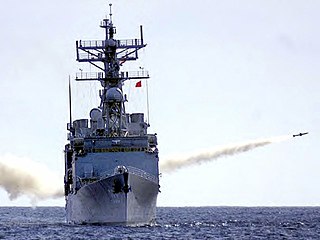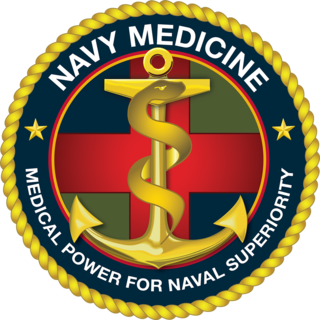
USS Kearsarge (CV/CVA/CVS-33) was one of 24 Essex-class aircraft carriers completed during or shortly after World War II for the United States Navy. The ship was the third US Navy ship to bear the name, and was named for a Civil War-era steam sloop. Kearsarge was commissioned in March 1946. Modernized in the early 1950s as an attack carrier (CVA), she served in the Korean War, for which she earned two battle stars. In the late 1950s she was further modified to become an anti-submarine carrier (CVS). Kearsarge was the recovery ship for the last two manned Project Mercury space missions in 1962–1963. She completed her career serving in the Vietnam War, earning five battle stars.

The Seventh Fleet is a numbered fleet of the United States Navy. It is headquartered at U.S. Fleet Activities Yokosuka, in Yokosuka, Kanagawa Prefecture, Japan. It is part of the United States Pacific Fleet. At present, it is the largest of the forward-deployed U.S. fleets, with 50 to 70 ships, 150 aircraft and 27,000 Sailors and Marines. Its principal responsibilities are to provide joint command in natural disaster or military operations and operational command of all US naval forces in the region.

USS Saint Paul (CA-73), a Baltimore-class cruiser, was the second ship of the United States Navy to be named for Saint Paul, Minnesota.

USS Bunker Hill (CG-52) is a Ticonderoga-class guided missile cruiser of the United States Navy constructed by Litton-Ingalls Shipbuilding Corporation at Pascagoula, Mississippi and launched on 11 March 1985. The Ticonderoga-class cruisers are equipped with the Aegis Combat System and Bunker Hill is the first of the class to be equipped with the Mark 41 Vertical Launching System (VLS) in place of the previous ships' twin-arm Mark 26 missile launchers, which greatly improved the flexibility and firepower of the ships by allowing them to fire BGM-109 Tomahawk cruise missiles for land attack missions. Other missions include ballistic missile defence and capital ship escort for anti-aircraft defense. The ship was commissioned on 20 September 1986 and is homeported at Naval Base San Diego in San Diego, California.

USS Hewitt (DD-966), named for Admiral H. Kent Hewitt USN (1887–1972), was a Spruance-class destroyer built by the Ingalls Shipbuilding Division of Litton Industries at Pascagoula, Mississippi and launched on 14 September 1974 by Mrs. Leroy Hewitt Taylor and Mrs. Gerald Hewitt Norton, daughters of Admiral Hewitt.

USS Providence (CL–82/CLG-6/CG-6) was a Cleveland-class light cruiser and the fourth ship of the United States Navy to be named after the city of Providence, Rhode Island. Providence was commissioned between 1945 and 1949. From 1957 to 1959, she was converted to a guided missile cruiser and flagship. She served in that role from 1959 to 1973. After her decommissioning, she was finally scrapped in 1980.

USS Curtis Wilbur (DDG-54) is the fourth Arleigh Burke-class guided missile destroyer. Curtis Wilbur was named for Curtis D. Wilbur, forty-third Secretary of the Navy, who served under President Calvin Coolidge. In 2016, she was based at Yokosuka, Japan, as part of Destroyer Squadron 15.

USS Curts (FFG-38) was the twenty-ninth ship of the Oliver Hazard Perry-class of guided-missile frigates. She was named for Admiral Maurice Curts (1898–1976). Curts is the first ship of that name in the US Navy.

USS Flasher (SSN-613), a Permit-class submarine, was the second ship of the United States Navy to be named for the flasher, a member of the fish family Lobotidae, which have an unusual placement of the second dorsal and anal fins, posteriorly located on the body, close to the tail.

USS Collett (DD-730) was a World War II-era Allen M. Sumner-class destroyer in the service of the United States Navy.

USS Tautog (SSN-639), a Sturgeon-class attack submarine, was the second ship of the United States Navy to be named for the Tautog, a wrasse commonly found along the Northern Atlantic coast. The submarine was in service from 17 August 1968 to 31 March 1997.

USS Columbus (SSN-762) is a Los Angeles-class nuclear powered fast attack submarine and the second vessel of the United States Navy to be named for Columbus, Ohio. The contract to build her was awarded to the Electric Boat Division of General Dynamics Corporation in Groton, Connecticut, on 21 March 1986 and her keel was laid down on 9 January 1991. She was launched on 1 August 1992 sponsored by Mrs. Margaret DeMars, wife of Admiral Bruce DeMars and commissioned on 24 July 1993.

USS Santa Fe (SSN-763), a Los Angeles-class submarine, is the second ship of the United States Navy to be named for Santa Fe, New Mexico. The contract to build her was awarded to the Electric Boat Division of General Dynamics Corporation in Groton, Connecticut on 21 March 1986 and her keel was laid down on 9 July 1991. She was launched on 12 December 1992 sponsored by Mrs. Joy Johnson, and commissioned on 8 January 1994, with Commander Rodger P. Krull in command.

United States Fleet Activities Yokosuka or Commander Fleet Activities Yokosuka is a United States Navy base in Yokosuka, Japan. Its mission is to maintain and operate base facilities for the logistic, recreational, administrative support and service of the U.S. Naval Forces Japan, Seventh Fleet and other operating forces assigned in the Western Pacific. CFAY is the largest strategically important U.S. naval installation in the western Pacific.

USS De Haven (DD-727), an Allen M. Sumner-class destroyer, was the second ship of the United States Navy to be named for Lieutenant Edwin J. De Haven. De Haven served aboard the Vincennes, flagship of the Wilkes Expedition, officially known as the United States Exploring Expedition, from 1839 to 1842. De Haven also served in the Mexican–American War, assisting in the capture of the Mexican schooner Creole. He was placed on the retired list in February 1862. He died in Philadelphia on 1 May 1865.

USS Hector (AR-7) was a repair ship that served in the United States Navy from 1944 to 1987 and as PNS Moawin in the Pakistan Navy from 1989 to 1994.

The Bureau of Medicine and Surgery (BUMED) is an agency of the United States Department of the Navy that manages health care activities for the United States Navy and the United States Marine Corps. BUMED operates hospitals and other health care facilities as well as laboratories for biomedical research, and trains and manages the Navy's many staff corps related to medicine. Its headquarters is located at the Defense Health Headquarters in Fairfax County, Virginia. BUMED has 63,000 medical personnel and more than a million eligible beneficiaries.

Nancy J. Lescavage is a retired American rear admiral who served as the 20th director of the Navy Nurse Corps and was the commander of Naval Medical Education and Training Command, Bethesda, Maryland.

Vice Admiral Matthew L. Nathan served as the 37th Surgeon General of the United States Navy.

William J. McDaniel is a retired Rear Admiral of the United States Navy. He served in the Medical Corps and was Commander of the Naval Medical Center Portsmouth in Portsmouth, Virginia.





















